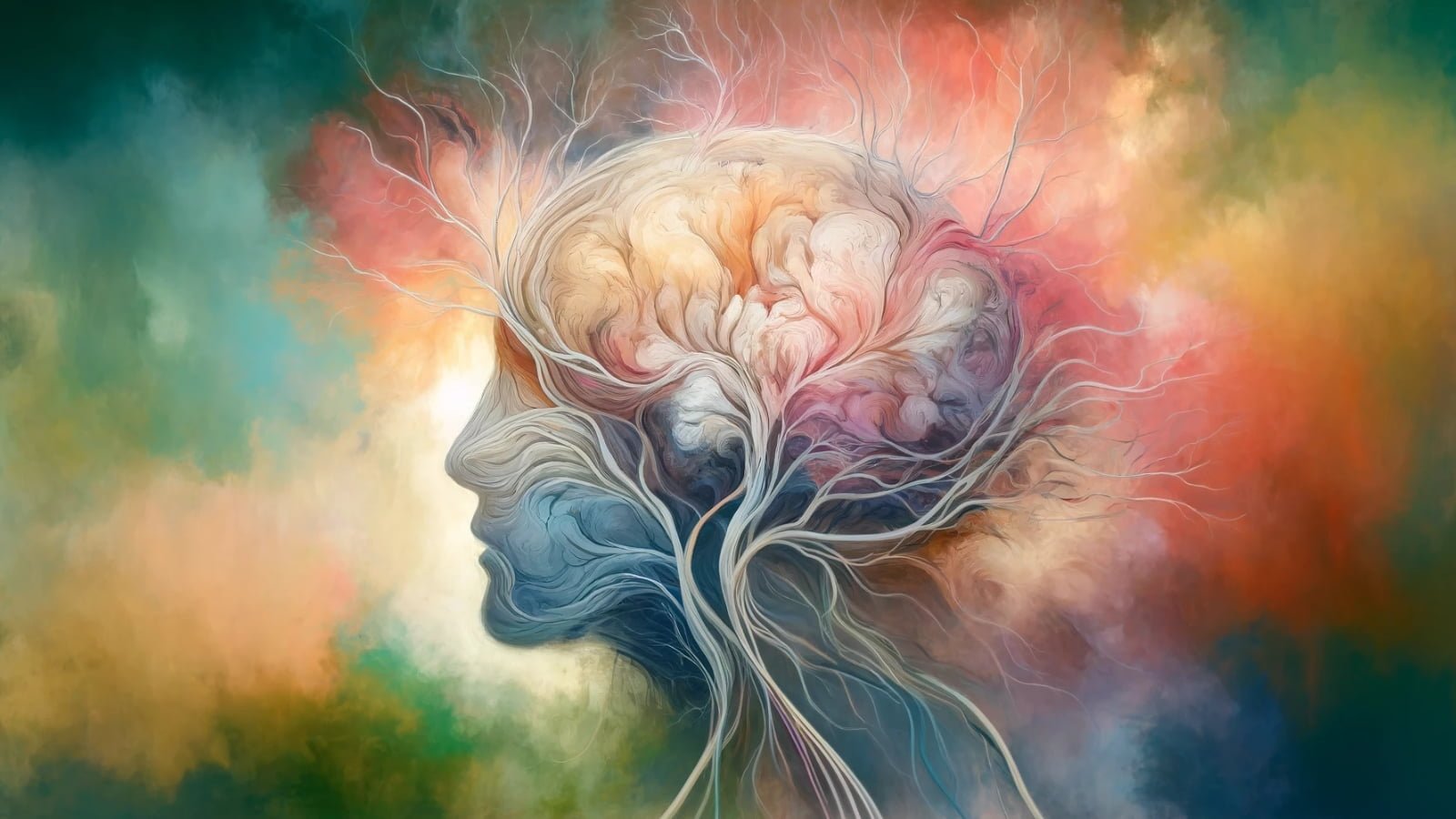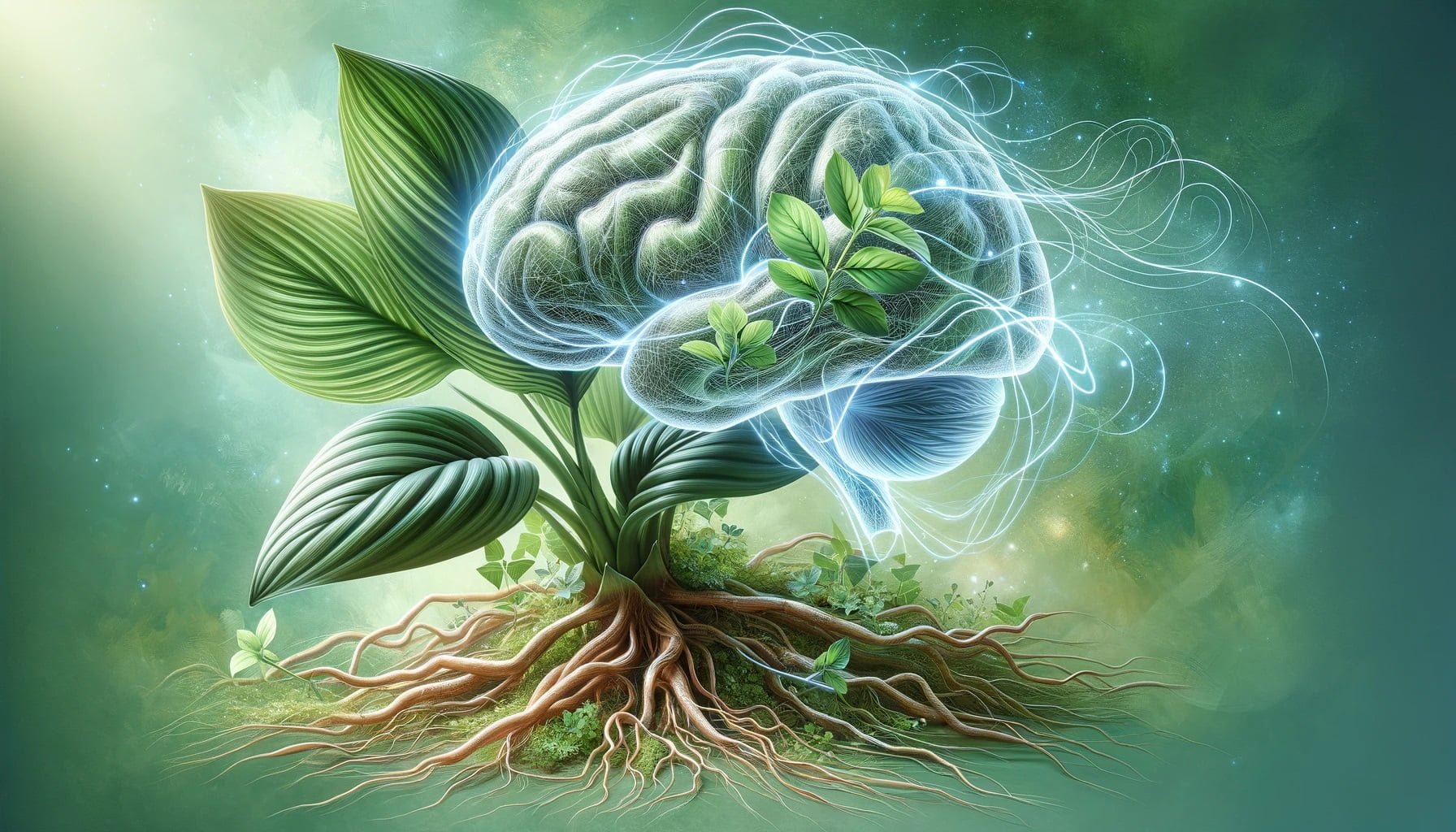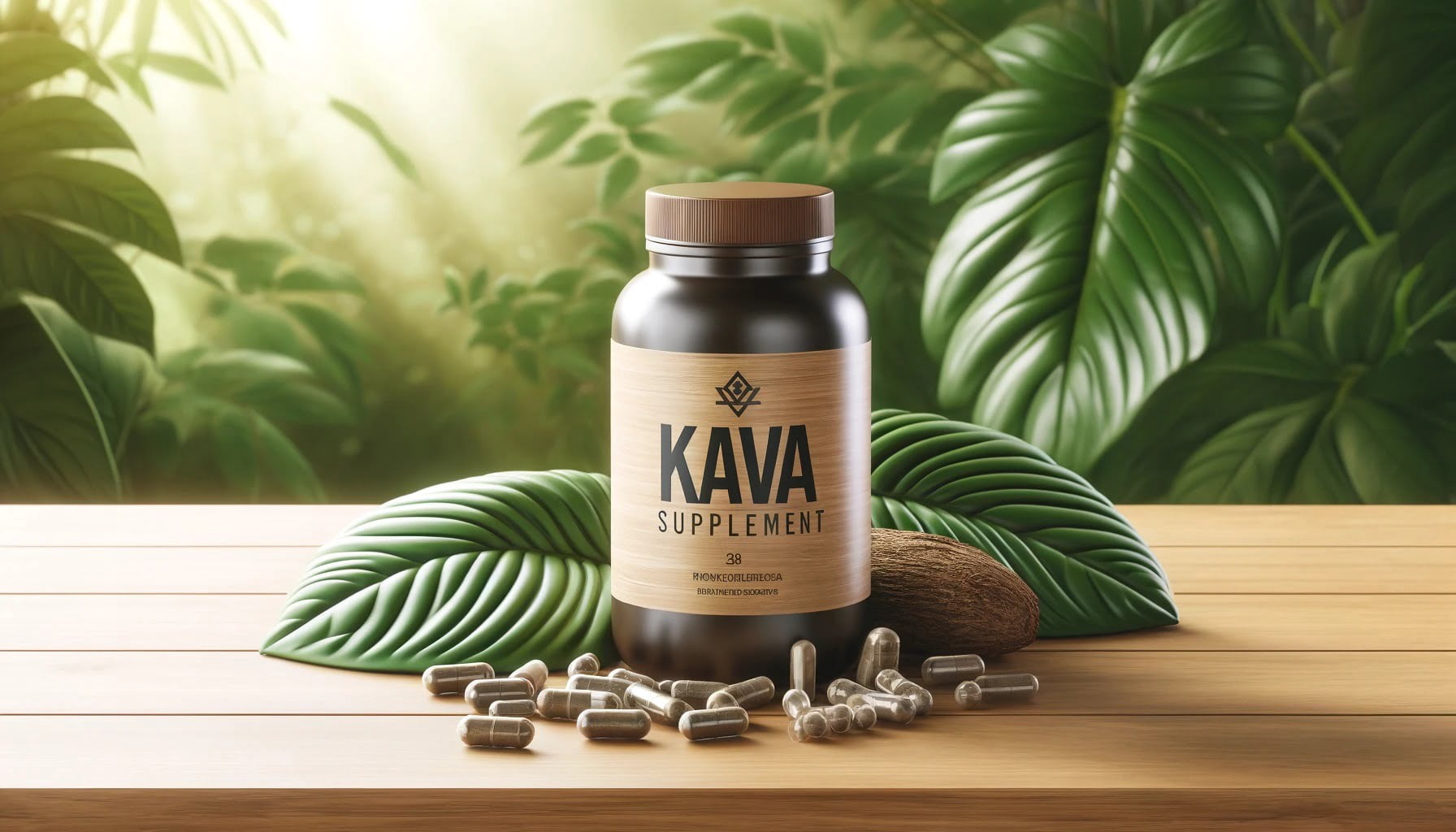
Kava is a plant, native to the South Pacific, that has sedative, anesthetic, and euphoriant properties.
It’s traditionally used as a beverage to alleviate stress and is effective in reducing anxiety and improving sleep quality. It also aids memory and learning.
In this article, we will discuss the science behind Kava’s mechanism of action, its potential side effects and interactions, and optimal dosages.
Table of Contents
What Is Kava?
Kava (Piper methysticum) is a plant native to the Pacific Islands.

The active compounds in kava, kavalactones, are responsible for its anxiolytic, memory boosting, attention enhancing, and anti-depressive effects.
These kavalactones interact with neurotransmitter systems in the brain, primarily enhancing GABA activity, which is then involved in producing its therapeutic effects.
Additionally, they inhibit MAO-B (Monoamine Oxidase B), elevating dopamine (pleasure hormone) and serotonin (happiness hormone) levels, for mood enhancement.
Kava also reduces reuptake of the excitatory neurotransmitter Noradrenaline, interacts with inflammation receptors, and modulates sodium and calcium ion channels in the brain.
What are the Traditional Uses of Kava?
Kava is a well-known natural remedy for depression, stress, anxiety, and sleep issues.
It has been traditionally used as a psychoactive beverage among Pacific Island cultures like Fiji, Tonga, and Samoa.
It is made by grinding the rhizomes (roots) of the kava plant and then mixed with water or coconut milk. Its consumption alleviates stress and induces a sense of calm.
Kava’s anxiolytic effects have also been used for therapeutic effects like pain relief, memory enhancement, and improving mood.
What are the Active Compounds in Kava and How Do They Function?
The main active compounds in kava are kavalactones, a class of lactone compounds that are structurally related to the psychoactive alkaloids found in other plants, like coffee and coca.
The six major kavalactones are:
- Kavain: Promotes relaxation and reduces anxiety
- Dihydrokavain: Enhances mood and has mild sedative effects
- Methysticin: Contributes to the anxiolytic and sedative properties
- Dihydromethysticin: Produces anxiolytic and anti-inflammatory properties
- Yangonin: Influences mood and brain functions
- Desmethoxyyangonin: Euphoric effects
These kavalactones act on various neurotransmitter systems in the brain.
What Are the Nootropic Benefits of Kava?
The capabilities of kava to enhance mental clarity, focus, sleep, and overall brain functions are indigenously and scientifically verified.
Based on its variety of nootropic benefits, kava is a top-shelf natural herb because of its anxiolytic effects.
Its many uses make kava a necessary supplement for people with depressive disorders, stress issues, and learning incapacities.

What Is the Role of Kava in Stress and Anxiety Reduction?
Kava affects GABA receptors which act like a brake on nerve impulses, promoting relaxation and reducing anxiety.
Studies have shown that kava extracts bind to GABA-A receptors, similar to how benzodiazepine (anti-anxiety medication) and oxazepam (anxiety disorder medication) work.(1)
Additionally, kava modulates other neurotransmitter activity (noradrenaline, dopamine, and serotonin), promoting well-being and relaxation.
Kava also hinders voltage-gated sodium ion channels in nerve cells, which provide calming effects in high anxiety situations.(2)
A study conducted for 75 patients with GAD produced favorable outcomes, by showing kava’s consistency in inducing its anxiolytic effects.(3)
Can Kava Alleviate Symptoms of Depression and Support Mood?
Kava helps increase dopamine levels and exerts mood-elevating effects, counteracting the symptoms of depression.
Kava also reduces the production of thromboxane A2, which blocks GABA-A receptors. This way, kava stops excessive neural inhibition linked to depression.
One particular study investigated the effects of kava’s administration on young adults, showing significantly reduced depressive symptoms.(4)
Another study compared a standardized kava extract to a placebo in 40 patients with depressive symptoms. After 4 weeks, the depressive symptoms saw a sharp reduction.(5)
How Does Kava Affect Sleep Quality?
Kava enhances sleep quality by blocking voltage-gated sodium ion channels, helping induce and maintain sleep.
A study found that kava improves sleep quality and promotes calmness by blocking calcium ion channels.(6) Blocking calcium channels alters the release of serotonin, dopamine, and GABA, which are involved in regulating sleep and wakefulness.
Another study found that kava improved self-rated sleep quality and reduced stress-induced insomnia in a group of 24 adults with mild anxiety disorders.(7)
Can Kava Improve Memory and Learning?
Kava mainly impacts memory and learning mechanisms as a subsidiary of its anxiolytic effects. Pressure, anxiety, and stress are well known to impact memory formation and retention negatively.
Kava mitigates this cause of memory weakening.
A study found that kava extract improved attention and visual processing in a group of 20 healthy volunteers, by inducing calmness in a high-pressure environment.(8)
Kava also uses GABAergic mechanisms, while modulating dopamine and serotonin levels in our nervous system. Both transmission channels boost emotions and mood regulation, serving to improve learning outcomes.
Another study investigated kava’s memory retention claims in elderly participants. It found that a single dose of kava extract (300 mg) improved word recognition and visual attention compared to the placebo.(9)
How to Consume Kava for Best Results?
To experience the nootropic benefits of kava, it’s important to be mindful of its suitability to you, and when and how much you take it.

For best results, follow these guidelines:
- Consult a Healthcare Professional: Determine suitability and ensure its safety
- Follow the Label: Recommended Kava dosage and timing
- Use with Meals: Enhance absorption and minimize gastrointestinal discomfort
- Healthy lifestyle: Regular exercise, balanced diet
What Is the Recommended Dosage of Kava?
Here is a general dosage guide based on the form of kava:
| Form | Kavalactone Content | Dosage |
| Dry Root Powder | 3-20% | 2-4 grams |
| Capsules/Tablets | 30-70% | 1-2 capsules |
| Liquid tincture | Varies | 2 – 4 mL |
| All forms of dosages should be taken 1-3 times per day | ||
The general dosage range of kavalactones (per serving) is between 60-250 mg, which can be gradually increased to 150-250 mg.
What Are the Potential Side Effects of Kava?
While kava is well-tolerated, it can cause side effects in some individuals, especially at high doses or with prolonged use.
So, it’s important to be aware of the potential risks and use kava responsibly.
Can Kava Cause Adverse Reactions?
Yes, using kava can lead to mild side effects, which include:
- Headache
- Dizziness
- Drowsiness
- Fatigue
- Nausea
- Stomach upset
- Skin rash
- Allergic reactions (rare)
These side effects are more likely to occur at high doses (>250 mg kavalactones) or in sensitive individuals.
They usually resolve on their own with continued use or by reducing the dose.
Can Kava Have Negative Interactions with Other Medications?
Yes, kava may have additive effects with other sedatives and CNS depressants, increasing the risk of excessive drowsiness, motor impairment, and respiratory depression. These include:
- Benzodiazepines (e.g., diazepam, lorazepam)
- Barbiturates (e.g., phenobarbital)
- Opioids (e.g., codeine, oxycodone)
- Alcohol
- Anticonvulsants (e.g., gabapentin, pregabalin)
- Muscle relaxants (e.g., cyclobenzaprine)
- Antihistamines (e.g., diphenhydramine)
Kava should be used cautiously or avoided in certain reactionary cases.
If you take any medications or supplements regularly, it’s important to consult with a healthcare provider before using kava to avoid potentially dangerous interactions.
Who Should Avoid Kava?
While kava is safe for most healthy adults when used appropriately, certain individuals should avoid it or use it with caution:
- Pregnant or breastfeeding women
- Children and adolescents
- People with liver disease
- Heavy alcohol users
- People with Parkinson’s disease
- People taking certain medications
- People with allergies to kava or other Piper species
Is Long-Term Kava Supplementation Safe?
More serious adverse effects have been reported in rare cases, particularly with heavy, long-term kava use (>400 mg kavalactones per day for several months). These include:
- Elevated liver enzymes
- Hepatitis
- Cirrhosis
- Liver failure
How Does Kava Compare to Other Nootropics?
Kava is just one of many natural nootropics that are used to enhance cognitive function and mental well-being.
How Does Kava Stack Up Against Popular Herbs and Supplements?
Here’s a comparison of kava with some other commonly used nootropic herbs and supplements:
- L-Theanine: Offers milder stress reduction compared to kava
- Ashwagandha: Inhibits long-term stress, kava affects immediate relaxation
- Bacopa Monnieri: Takes weeks for benefits, kava offers immediate stress relief
- Valerian Root: Induces sleep more effectively than kava
Can Kava Be Combined with Other Nootropics for Enhanced Effects?
Yes, kava can be combined with other nootropics to enhance its effects or provide complementary benefits.
Some nootropics that have synergistic effects with kava include:
- L-Tyrosine: Enhances relaxation and anxiety relief
- Gingko Biloba: Balances acute stress relief and long-term cognitive support
- CBD: Enhances stress-relieving and relaxation effects
- Curcumin: Supports stress response modulation through neurotransmitter function
When combining kava with other supplements, it’s important to start with lower doses of each to assess your tolerance and avoid potential side effects.
Combining with other sedatives can increase the risk of drowsiness and impairment.
- Sarris, Jerome, et al. “Kava in the treatment of generalized anxiety disorder: a double-blind, randomized, placebo-controlled study.” Journal of clinical psychopharmacology 33.5 (2013): 643-648.↩
- Sarris, Jerome, et al. “Herbal medicine for depression, anxiety and insomnia: a review of psychopharmacology and clinical evidence.” European neuropsychopharmacology 21.12 (2011): 841-860.↩
- Singh, Yadhu N., and Nirbhay N. Singh. “Therapeutic potential of kava in the treatment of anxiety disorders.” CNS drugs 16 (2002): 731-743.↩
- Gleitz, Johannes, et al. “Antithrombotic action of the kava pyrone (+)-kavain prepared from Piper methysticum on human platelets.” Planta medica 63.01 (1997): 27-30.↩
- Prinsloo, Denise, et al. “Monoamine oxidase inhibition by kavalactones from kava (piper methysticum).” Planta medica 85.14/15 (2019): 1136-1142.↩
- McPartland, John M., Geoffrey W. Guy, and Vincenzo Di Marzo. “Care and feeding of the endocannabinoid system: a systematic review of potential clinical interventions that upregulate the endocannabinoid system.” PloS one 9.3 (2014): e89566.↩
- Bilia, Anna Rita, Sandra Gallori, and Franco F. Vincieri. “Kava-kava and anxiety: growing knowledge about the efficacy and safety.” Life Sciences 70.22 (2002): 2581-2597.↩
- Witte, Steffen, Dieter Loew, and Wilhelm Gaus. “Meta‐analysis of the efficacy of the acetonic kava‐kava extract WS® 1490 in patients with non‐psychotic anxiety disorders.” Phytotherapy Research: An International Journal Devoted to Pharmacological and Toxicological Evaluation of Natural Product Derivatives 19.3 (2005): 183-188.↩
- Thompson, Richard, Willibald Ruch, and Rüdiger U. Hasenöhrl. “Enhanced cognitive performance and cheerful mood by standardized extracts of Piper methysticum (Kava‐kava).” Human Psychopharmacology: Clinical and Experimental 19.4 (2004): 243-250.↩

